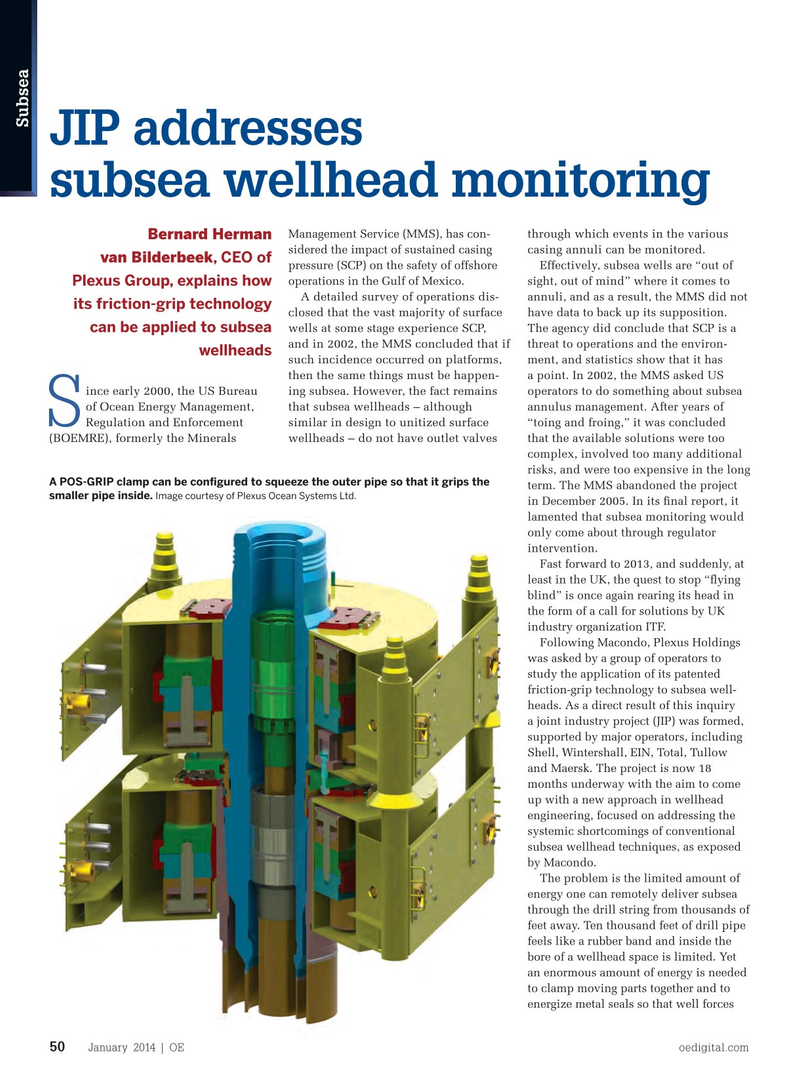
Page 48: of Offshore Engineer Magazine (Jan/Feb 2014)
Read this page in Pdf, Flash or Html5 edition of Jan/Feb 2014 Offshore Engineer Magazine
Subsea
JIP addresses subsea wellhead monitoring
Management Service (MMS), has con- through which events in the various
Bernard Herman sidered the impact of sustained casing casing annuli can be monitored. van Bilderbeek, CEO of pressure (SCP) on the safety of offshore Effectively, subsea wells are “out of operations in the Gulf of Mexico. sight, out of mind” where it comes to
Plexus Group, explains how
A detailed survey of operations dis- annuli, and as a result, the MMS did not its friction-grip technology closed that the vast majority of surface have data to back up its supposition. wells at some stage experience SCP,
The agency did conclude that SCP is a can be applied to subsea and in 2002, the MMS concluded that if threat to operations and the environ- wellheads such incidence occurred on platforms, ment, and statistics show that it has then the same things must be happen- a point. In 2002, the MMS asked US ince early 2000, the US Bureau ing subsea. However, the fact remains operators to do something about subsea of Ocean Energy Management, that subsea wellheads – although annulus management. After years of
S
Regulation and Enforcement similar in design to unitized surface “toing and froing,” it was concluded (BOEMRE), formerly the Minerals wellheads – do not have outlet valves that the available solutions were too complex, involved too many additional risks, and were too expensive in the long
A POS-GRIP clamp can be confgured to squeeze the outer pipe so that it grips the term. The MMS abandoned the project smaller pipe inside. Image courtesy of Plexus Ocean Systems Ltd.
in December 2005. In its fnal report, it lamented that subsea monitoring would only come about through regulator intervention.
Fast forward to 2013, and suddenly, at least in the UK, the quest to stop “fying blind” is once again rearing its head in the form of a call for solutions by UK industry organization ITF.
Following Macondo, Plexus Holdings was asked by a group of operators to study the application of its patented friction-grip technology to subsea well- heads. As a direct result of this inquiry a joint industry project (JIP) was formed, supported by major operators, including
Shell, Wintershall, EIN, Total, Tullow and Maersk. The project is now 18 months underway with the aim to come up with a new approach in wellhead engineering, focused on addressing the systemic shortcomings of conventional subsea wellhead techniques, as exposed by Macondo.
The problem is the limited amount of energy one can remotely deliver subsea through the drill string from thousands of feet away. Ten thousand feet of drill pipe feels like a rubber band and inside the bore of a wellhead space is limited. Yet an enormous amount of energy is needed to clamp moving parts together and to energize metal seals so that well forces
January 2014 | OE oedigital.com 50 050_0114_subsea3_Plexus.indd 50 12/19/13 4:07 PM

 47
47

 49
49